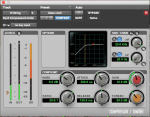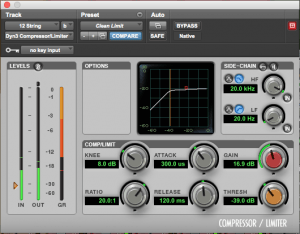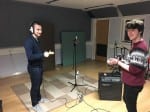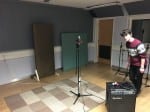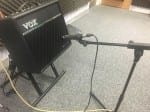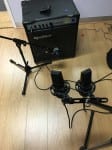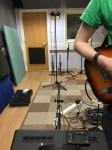The purpose of my Audio Project B was to create an Extended Play, which would consist of five songs produced by myself and Adam Thraves. We were initially unsure on whether to produce another artist’s or to record ourselves as a studio band as we wanted to showcase our musicianship as well as our production. We started out recording just as a duo but soon developed into a full band called ‘Arabian Oryx’ when we were joined by our friends, Patrick and Jack, who contributed various parts to the songs such as piano, vocals or guitar where needed.
At the start of this project I outlined my learning outcomes which included developing my technical skills through the use of different production methods. I did this through the recording, mixing and mastering stages. As seen in my blog posts detailing the studio sessions, I employed various recording techniques that I hadn’t used before to either get the best out of the performances or to experiment with techniques, producing sounds that were unconventional or unintended. A perfect example of this was on ‘For My Next Trick’ where we not only recorded the guitar track through the amplifier, but also used boundary microphones (placed on both sides of the wall in the live room) to pick up the extra ambient sound. This was successful enough to be repeated on ‘Father, Son’ where we utilised the technique for the slide guitar part to achieve the ethereal tonality heard on the end of the song. This method shows that I have improved my technical skills as I would normally just use artificial reverb, normally applied in mixing, to achieve the atmospheric sound.
Unfortunately not all the new methods that were utilised were so successful. An example of this came about when we were mixing the song ‘Father, Son’. The use of a matched pair of microphones to record an acoustic guitar part had resulted in audio bleed from the headphones due to the close proximity as well as other unwanted sounds. I wouldn’t say this hindered the project too much and similar problems were easily rectified either by mixing or, in this particular case, re-recording the part with a different microphone set-up. Another part of the project was to use different mastering methods to achieve the final sound. The plan was to use the Izotope mastering software in the Multitrack. We put the final mixes through a ProTools session and used the plug-in called ‘Izotope Ozone 7’. Although it added a bit of volume to the songs, we found that it made them fuzzy and distorted to the point of it not being usable. We tried various pre-sets and altered the level at which it was applied but by that point it wasn’t adding anything extra and was actually detracting from the mixes that we had made over the process. It’s a shame that this was an unsuccessful part of the project as I was hoping to use the new software to meet my second learning outcome. It hasn’t ruined the project though and I would say that the EP sounds good enough without the addition of the Izotope software. The use of ‘Maxim Limiter’ brought the levels of the songs up anyway which was the only problem we had previously encountered.
Although this project was intended to showcase my production skills for future work, it was also a chance to prove myself as an aspiring musician. This was reflected in another of my learning objectives which was to develop my musicianship and arrangement skills by embellishing my previously written songs showcasing the role of session musician as well as that of producer. This was shown in ‘Father, Son’ in which I am the only performer on the track, which includes acoustic guitar, keyboards, mandolin, melodica and a slide guitar part. The original demo didn’t have all of these overdubs present, showing how the ambition of my recording ethos has grown and my musicianship improved. I also acquired a bass guitar during this process, an instrument on which I have had no previous experience playing. Both ‘Baby’ and ‘Ironic Veronica’ feature my bass-lines, showing how much my proficiency on the instrument has evolved over the course of project. The fact that I wrote two new songs (‘For My Next Trick’ and ‘Sip a Fizzy Pop’) for the project displays my compositional skills and ability to develop a song in a short amount of time from an acoustic guitar piece to a fully-fledged band recording.
The third aim of the project was for me to research my influences and apply them appropriately to the product. I researched various bands and artists that I liked to see how they achieved the sound that they wanted. One of these was Arctic Monkeys with their 2011 album ‘Suck it and See’, which is a big inspiration for some of my song writing. Through the use of ‘SoundonSound’ articles I was able to look at the way they recorded that album and then apply it to my own project either by using the exact method or developing it to be more applicable to it. A perfect example of this would be the choice of microphone as detailed in my post on ‘Sip a Fizzy Pop’ as a way to achieve the guitar sound of the record. Some of this learning outcome was not so easily achieved though, as every album isn’t as well-documented as others. I looked into R.E.M. and their producer Scott Litt for inspiration on how they made both ‘Out of Time’ and ‘Automatic for the People’ but didn’t manage to find much beyond general stories about the sessions rather than technical details on equipment. I wouldn’t say it mattered too much though and overall the creation of the E.P shouldn’t have to rely on copying other artist’s methods to achieve the sound. We wanted to put our own style on the record and didn’t record anything merely on the basis of someone else doing it. There are of course influences on the album, as with any artist, but lots of it came through spontaneity rather than proper planning which can upset creativity.
Overall I would say that this project has been a success. I have greatly improved on my production skills and feel confident that I could apply them to future work. I have showcased my musicianship well and feel that this project could be a stepping stone into the industry as a musician/producer. I have met my learning outcomes and even where I haven’t to the extent I intended, I have still been able to justify it.

